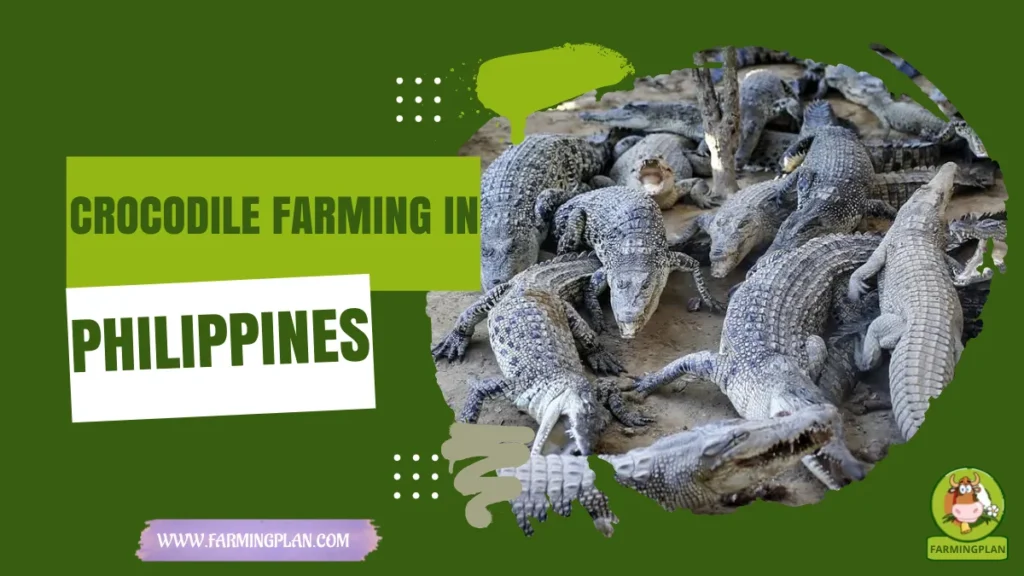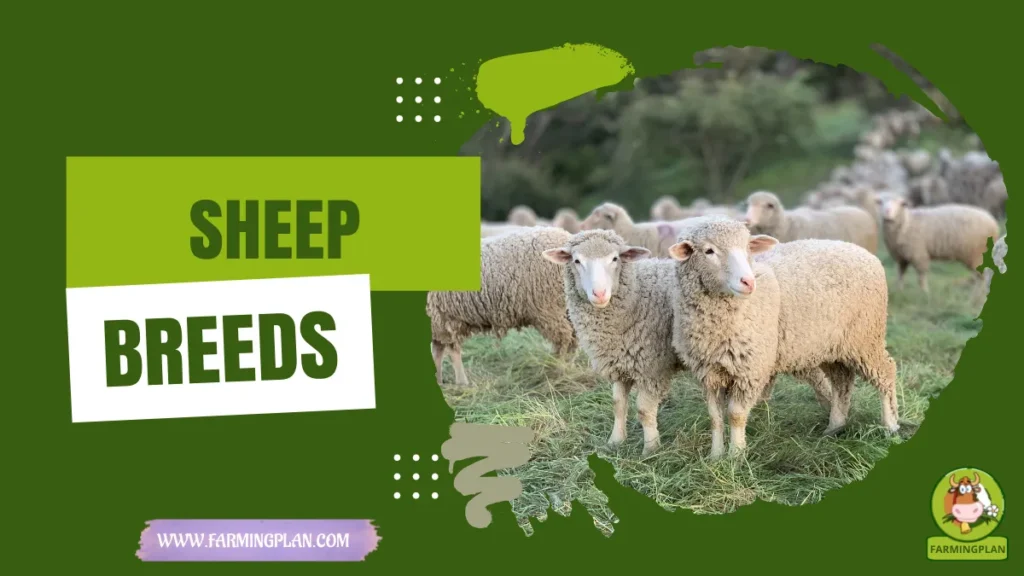Shetland Sheep are one of my all-time favorite heritage breeds. Why? Because these colorful little wool-makers are packed with personality, resilience, and history. If you’re a pet owner, homesteader, breeder, or just someone enchanted by sheep with fluffy coats and a rainbow of natural colors, Shetlands are a dream come true. In this guide, I’ll walk you through everything you need to know—from their ancient origins to how to care for them daily. Whether you’re into mini Shetland sheep, raising lambs for sale, or want a beautiful breed grazing your pasture, this is your go-to article for all things Shetland Sheep.

History & Origin of Shetland Sheep
Shetland Sheep, one of the oldest and most primitive sheep breeds in Britain, are a fascinating species. Hailing from the windswept Shetland Islands of Scotland, they have developed survival instincts to brave the cold, wet, and rugged terrain.
Their roots trace back to Northern European short-tailed sheep and even to wild sheep that grazed across the region centuries ago. By the 18th and 19th centuries, Shetland Sheep were a staple of island life. Their soft wool was spun by hand into fine yarns and garments—famous in traditional Shetland knitting.
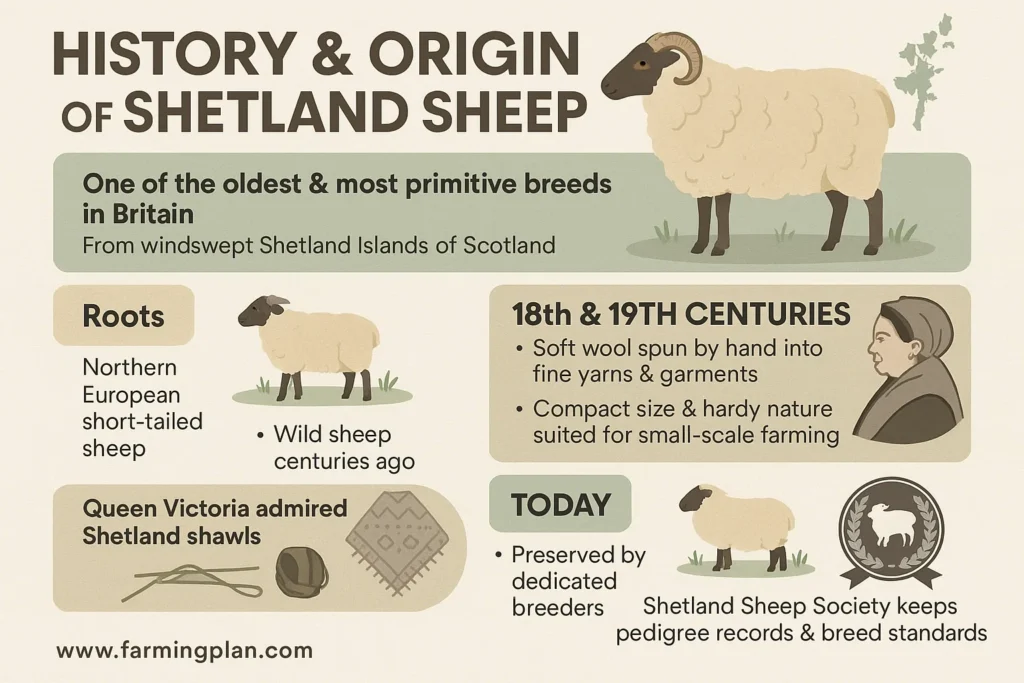
Their compact size, hardy nature, and low-maintenance care made them perfect for small-scale farmers and crofters. Even Queen Victoria admired Shetland shawls! Today, the breed is preserved through dedicated breeders and the Shetland Sheep Society, which keeps detailed pedigree records and breed standards to protect their legacy.
Read More: Burlina Cattle: Legendary Dairy Breed With Exceptional Milk
Characteristics
Let’s start with size—they’re tiny! Adult ewes usually weigh between 75–100 lbs, while rams can hit about 90–125 lbs. That’s why they’re often nicknamed “miniature Shetland sheep” or “mini Shetlands.” Despite the size, they’re quite sturdy and muscled for their frame.
Now, let’s talk wool—the crown jewel of the breed. Shetland wool is soft, and crimpy and comes in over 30 recognized colors and patterns, including moorit (brown), market (bluish-gray), shale (steel gray), and katmoget (light body with a dark belly). Fleece micron counts range from 20 to 30, making it perfect for handspinning and delicate crafts.
Some fleeces even rival Merino in softness. Their tails are short, like other northern short-tailed breeds. They also have clean faces and legs, with some irregular patches of color around the eyes or belly. Each Shetland is unique, and that’s part of their charm!
Nature & Temperament
Shetland Sheep aren’t just pretty—they’ve got personality. I always tell new farmers Shetlands are curious, clever, and surprisingly independent. Some are downright cuddly, while others may be shy at first. But with regular interaction, they become very docile. They’ve kept their primitive survival instincts, so they’re excellent at foraging and know how to dodge danger better than more commercial breeds. This makes them great for low-input systems, especially in conservation grazing.
That said, they can be a bit sassy. Rams especially might test fences or your patience during the breeding season, so always handle them with care. But for families or first-time owners, Shetland Sheep are a joy to raise—gentle with children and smart enough to learn routines fast. However, it’s important to be prepared for their independent nature and potential health issues, such as parasites and foot rot, which are common in sheep farming.
Read More: Merino Sheep: Ultimate Wool Breed for Elite Farmers
Food & Diet of Shetland Sheep
Shetlands are fantastic grazers. Their small size means they don’t eat as much as larger breeds, but they’re still excellent at cleaning up rough pastures. They thrive on good-quality grass, clover, and hay, and they don’t need rich feed to stay healthy.
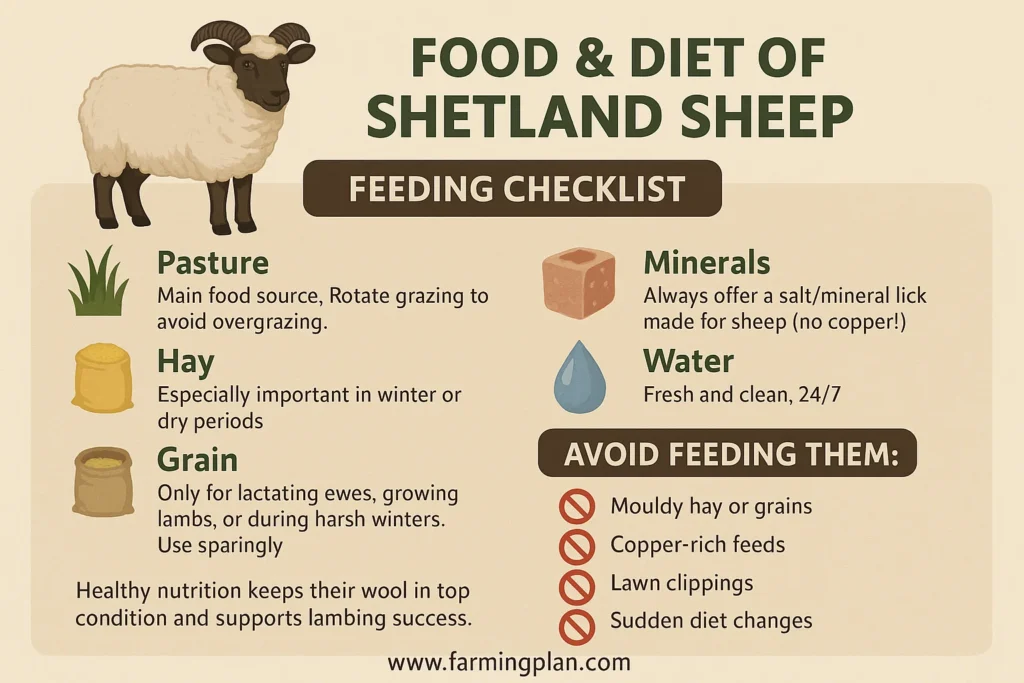
Here’s my feeding checklist:
- Pasture: Main food source. Rotate grazing to avoid overgrazing.
- Hay: Especially important in winter or dry periods.
- Grain: Only for lactating ewes, growing lambs, or during harsh winters. Use sparingly.
- Minerals: Always offer a salt/mineral lick made for sheep (no copper!).
- Water: Fresh and clean, 24/7.
Avoid feeding them:
- Mouldy hay or grains
- Copper-rich feeds
- Lawn clippings
- Sudden diet changes
Healthy nutrition keeps their wool in top condition and supports lambing success.
Usage & Purpose
Shetland Sheep serve many purposes. Their main claim to fame is, of course, their wool. Spinners and fiber artists love the natural fleece colors, and there’s always a market for Shetland sheep wool at craft fairs and online. But don’t overlook their meat. Although small, Shetland lamb meat is tender, lean, and packed with flavor. It’s a niche favorite with foodies and local markets.
Some farmers breed them for commercial meat production in small flocks. They also make great conservation grazers, helping manage land in an eco-friendly way. Their light hoofprints and nibbling habits make them ideal for maintaining biodiversity. And yes, they can be pets too! Many families raise Shetlands for fun, companionship, and the experience of working with livestock.
Special Features
Shetland Sheep are truly unique. Here are a few things that make them stand out:
- Color Diversity: Over 30 natural fleece colors and patterns.
- Fine Wool: Soft, crimpy, and easy to spin—some fleeces just 20 microns.
- Hardy Constitution: Can withstand rough weather and poor pastures.
- Long Life Span: Many live well over 10 years, making them long-term companions.
- Easy Lambing: Ewes are known for their maternal instincts and ample milk supply.
- Heritage Breed Status: Recognized by breed societies, helping preserve genetic diversity.
- Primitive Traits: Retain excellent instincts and foraging ability.
- Adaptability: Thrive in cold climates but also do well in temperate zones.
If you’re looking for a sheep breed that checks all the boxes—beauty, brains, and purpose—Shetlands are it.
“Tiny In Size But Mighty In Character—Shetland Sheep Prove That Good Things Truly Come In Woolly Packages.”
Health Issues & Prevention of Shetland Sheep
Like most primitive breeds, Shetlands are pretty healthy. But they’re still sheep—and that means some standard care is essential. Regular care and attention are crucial to maintaining their health and well-being.
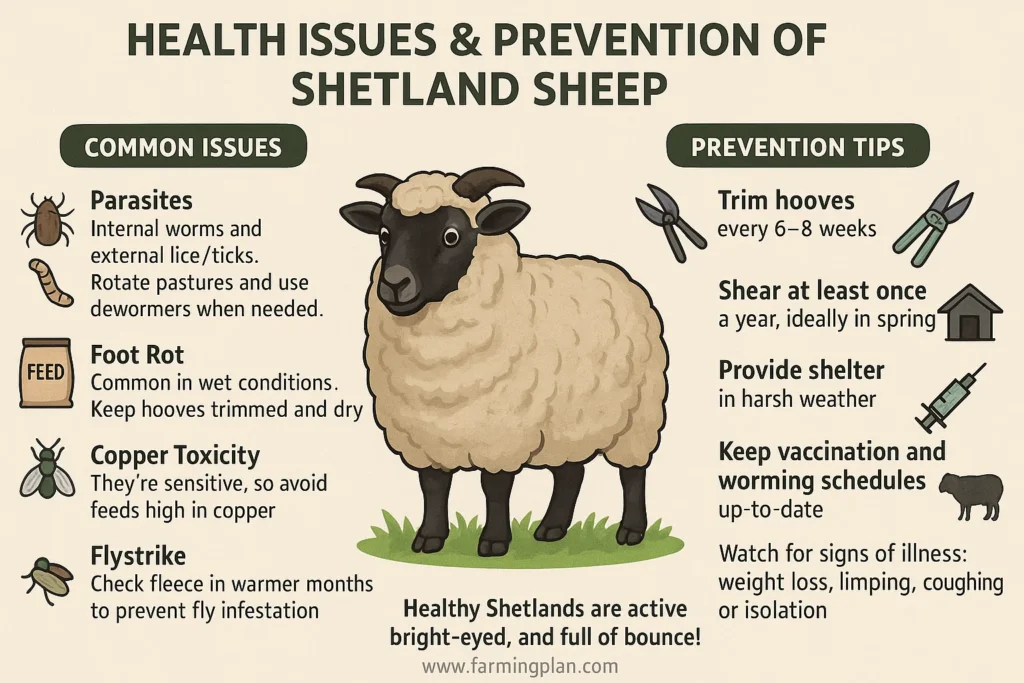
Common Issues:
- Parasites: Internal worms and external lice/ticks. Rotate pastures and use dewormers when needed.
- Foot Rot: Common in wet conditions. Keep hooves trimmed and dry.
- Copper Toxicity: They’re sensitive, so avoid feeds high in copper.
- Flystrike: Check fleece in warmer months to prevent fly infestation.
Prevention Tips:
- Trim hooves every 6–8 weeks.
- Shear at least once a year, ideally in spring.
- Provide shelter in harsh weather.
- Keep vaccination and worming schedules up-to-date.
- Watch for signs of illness: weight loss, limping, coughing, or isolation. Healthy Shetlands are active, bright-eyed, and full of bounce!
Step-by-Step Farming Guide
Step 1: Prepare the Perfect Setup
Start with good fencing—these sheep are clever and light on their feet. Use livestock panels or tight field fencing to keep them in. Provide a simple three-sided shelter or barn, especially for lambing season or extreme weather. Make sure they have shade, dry bedding, and access to clean water.
Step 2: Choose Your Starter Flock
Buy from reputable breeders with pedigree records. Start with at least two to three sheep—they’re herd animals and hate being alone. Decide if you’re raising them for wool, meat, breeding, or pets. Miniature Shetland sheep or colored lambs may have specific market appeal.
Step 3: Daily Care Routine
Feed them hay and let them graze. Check water and fence lines. Give them a quick visual health check—are they alert, walking well, and eating? This simple routine takes just 15–20 minutes a day. During lambing season, monitor ewes more closely and assist only if needed.
Step 4: Shearing & Wool Management
Shear once a year, usually in spring. You can do it yourself or hire a pro. Skirt the fleece (remove dirty edges) and store it in breathable bags. You can sell fleece directly, spin it, or turn it into felt or garments. Shetland wool practically sells itself to fiber fans!
Step 5: Breeding & Lambing
Breeding season is typically fall, with lambs born in spring. Rams should be introduced to ewes for 4–6 weeks. Watch for signs of heat and ensure ewes are well-fed. Most Shetland ewes lamb easily, often without help. Lambs nurse quickly and grow fast if the mom has ample milk.
Expert Tips & Best Practices
- Rotate pastures to reduce parasites and keep grass healthy.
- Keep a detailed flock journal—track weight, breeding, health, and wool yield.
- Talk to your sheep! They learn your voice and routines.
- Don’t overfeed grain—it can lead to bloat or illness.
- Use a sheep halter early, so they’re easier to handle later.
- Never keep a ram alone—they need companions, too.
- Join breed groups or the Shetland Sheep Society for support and networking.
- If you show sheep, teach them to walk on lead and stand calm—it’s fun!
FAQs
Are Shetland Sheep good for beginners?
Yes! They’re small, hardy, and easy to care for—perfect for new farmers or families.
How much wool does a Shetland sheep produce?
On average, they produce 2–4 lbs of fleece per year, depending on size and nutrition.
Can Shetland Sheep live in hot climates?
Yes, as long as they have shade, plenty of water, and are shorn regularly, they adapt well.
How long do Shetland Sheep live?
They often live 10–12 years, with some reaching up to 15 years with proper care.
Are Shetland lambs easy to sell?
Absolutely! There’s demand for lambs for wool, breeding, and meat, especially colored varieties.
Conclusion
Shetland Sheep are a rare combination of beauty, utility, and resilience. Whether you’re drawn to their soft wool, hardy constitution, or playful nature, these little charmers will quickly become a beloved part of your homestead or hobby farm. I’ve raised many breeds over the years, but none have brought as much color—literally and figuratively—into my life as the Shetland. They’re ideal for beginners and experienced shepherds alike. Ready to add a few Shetlands to your pasture? Trust me, you won’t regret it.

